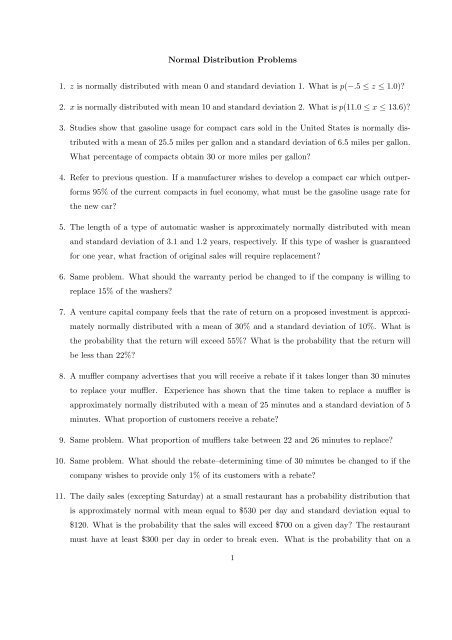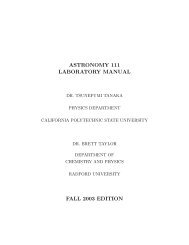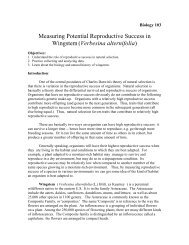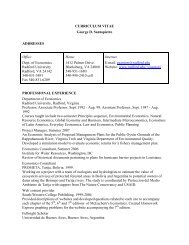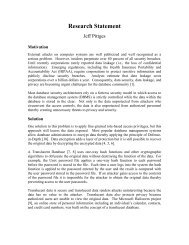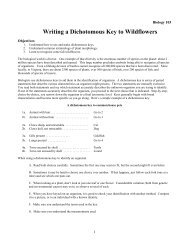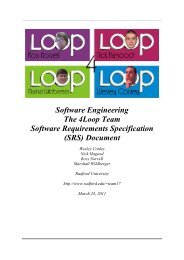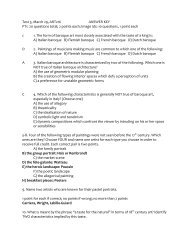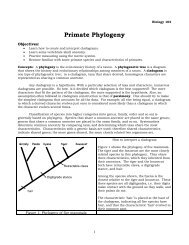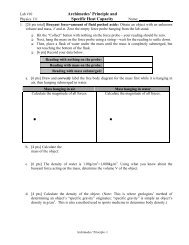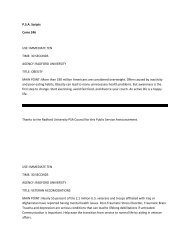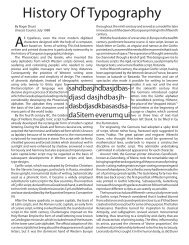Normal Distribution Examples
Normal Distribution Examples
Normal Distribution Examples
Create successful ePaper yourself
Turn your PDF publications into a flip-book with our unique Google optimized e-Paper software.
<strong>Normal</strong> <strong>Distribution</strong> Problems<br />
1. z is normally distributed with mean 0 and standard deviation 1. What is p(−.5 ≤ z ≤ 1.0)?<br />
2. x is normally distributed with mean 10 and standard deviation 2. What is p(11.0 ≤ x ≤ 13.6)?<br />
3. Studies show that gasoline usage for compact cars sold in the United States is normally distributed<br />
with a mean of 25.5 miles per gallon and a standard deviation of 6.5 miles per gallon.<br />
What percentage of compacts obtain 30 or more miles per gallon?<br />
4. Refer to previous question. If a manufacturer wishes to develop a compact car which outperforms<br />
95% of the current compacts in fuel economy, what must be the gasoline usage rate for<br />
the new car?<br />
5. The length of a type of automatic washer is approximately normally distributed with mean<br />
and standard deviation of 3.1 and 1.2 years, respectively. If this type of washer is guaranteed<br />
for one year, what fraction of original sales will require replacement?<br />
6. Same problem. What should the warranty period be changed to if the company is willing to<br />
replace 15% of the washers?<br />
7. A venture capital company feels that the rate of return on a proposed investment is approximately<br />
normally distributed with a mean of 30% and a standard deviation of 10%. What is<br />
the probability that the return will exceed 55%? What is the probability that the return will<br />
be less than 22%?<br />
8. A muffler company advertises that you will receive a rebate if it takes longer than 30 minutes<br />
to replace your muffler. Experience has shown that the time taken to replace a muffler is<br />
approximately normally distributed with a mean of 25 minutes and a standard deviation of 5<br />
minutes. What proportion of customers receive a rebate?<br />
9. Same problem. What proportion of mufflers take between 22 and 26 minutes to replace?<br />
10. Same problem. What should the rebate–determining time of 30 minutes be changed to if the<br />
company wishes to provide only 1% of its customers with a rebate?<br />
11. The daily sales (excepting Saturday) at a small restaurant has a probability distribution that<br />
is approximately normal with mean equal to $530 per day and standard deviation equal to<br />
$120. What is the probability that the sales will exceed $700 on a given day? The restaurant<br />
must have at least $300 per day in order to break even. What is the probability that on a<br />
1
given day the restaurant will not break even?<br />
12. Suppose that the counts on the number of a particular type of bacteria in 1 milliliter of<br />
drinking water tend to be approximately normally distributed with a mean of 85 and a standard<br />
deviation of 9. What is the probability that a given 1 milliliter sample will contain more than<br />
100 bacteria?<br />
13. A professional painter has found that the area he can usually cover with a gallon of paint<br />
is normally distributed with a mean of 400 sq. ft. and a standard deviation of 50 ft. A<br />
manufacturer advertises that 1 gallon of his paint will cover between 375 sq. ft. and 450 sq.<br />
ft. What is the probability that the area covered by this paint will be within the advertised<br />
limits? What is the probability that the paint will cover more area than advertised?<br />
14. z is normally distributed with mean 0 and standard deviation 1. Verify the Empirical Rule by<br />
finding the following probabilities: p(−1 ≤ z ≤ 1), p(−2 ≤ z ≤ 2), and p(−3 ≤ z ≤ 3).<br />
15. x is normally distributed. Pick any mean µ and standard deviation σ you wish. Verify the<br />
Empirical Rule by finding the following probabilities:<br />
• p(µ − σ ≤ x ≤ µ + σ)<br />
• p(µ − 2σ ≤ x ≤ µ + 2σ)<br />
• p(µ − 2σ ≤ x ≤ µ + 2σ)<br />
2
Fact 2 (Central Limit Theorem):<br />
If x is any random variable with mean µ x and standard deviation σ x , then the sample mean x<br />
for samples of size N, is approximately normally distributed with mean µ x = µ x and standard<br />
deviation σ x = σ x<br />
√<br />
N<br />
.<br />
We will use this fact in two ways:<br />
i) We will assume we know µ x and σ x and calculate various probabilities involving x.<br />
ii) We will estimate an unknown population mean using x for a particular sample of size N.<br />
We will attach levels of confidence to our estimate and construct confidence intervals for<br />
the population mean of the form<br />
x + − something = (x − something , x + something) .<br />
For now we’ll concentrate on the first type of problem.<br />
Problems:<br />
1. For a certain population, µ x = 50 and σ 2 x = 64. A single sample of size 25 is drawn from this<br />
population. What is the probability that the mean for this sample is 54 or less?<br />
2. Same problem. What is the probability that the sample mean deviates by no more than 2<br />
units in either direction from the population mean?<br />
3. Same problem. The probability is 0.05 that the sample mean will be less than what value?<br />
4. For a certain population of people (yeah, you guessed it: cat lovers), the average number of<br />
cats in a household is 12 with a standard deviation of 9. A random survey of 16 of these foolish<br />
households is performed. What is the probability that the mean for this sample is more than<br />
10?<br />
5. Same problem. What is the probability that the sample mean is between 13 and 15?<br />
6. Same problem. The probability is 15% that the sample mean will be less than what value?<br />
7. Same problem. What is the probability I hung up the telephone and played a game called Cat<br />
Splat on my pc as soon as I heard the word cat when the people doing the survey called.<br />
3


